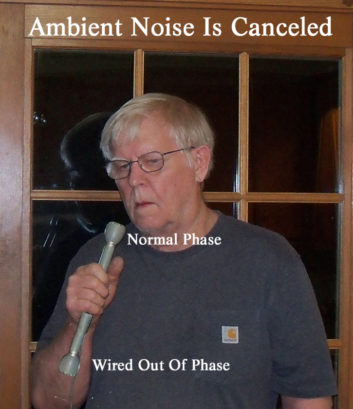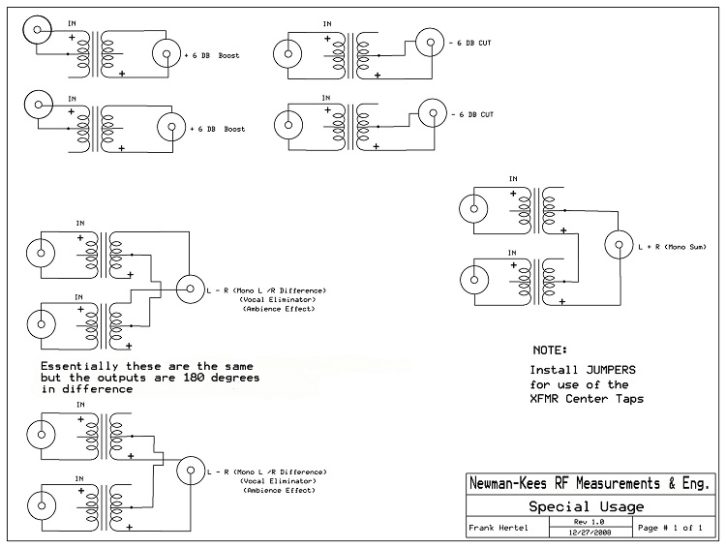 San Francisco contract engineer Bill Ruck awards Frank Hertel a gold star for his unique approach to a noise-reducing mic project as we described in August and shown here. Bill noted that a similar system was part of the Grateful Dead’s “Wall of Sound.”
San Francisco contract engineer Bill Ruck awards Frank Hertel a gold star for his unique approach to a noise-reducing mic project as we described in August and shown here. Bill noted that a similar system was part of the Grateful Dead’s “Wall of Sound.”
Bill adds that Frank connected his Pin 1 (ground) to the shell of the XLR connector, and says there are two camps in this regard. He has learned not to connect Pin 1 to the shell on his cables because it can induce all sorts of ground issues when interfacing to unfamiliar equipment. He says you never know what “The Other Guy” has done with his ground.
This is especially true with video. Remember that video is unbalanced and that the video folks tend to have a lot of crap on their ground systems. You could hear sync with analog NTSC; but today, SD just puts wideband noise everywhere.
Because of that potential for picking up noise, Bill made what Dan Healy, the Grateful Dead front-of-house mixer, called “the mother of all isolation boxes.”
It is a heavy steel box with four Western Electric 111C coils wired 1:1. The male and female connectors on the top were mounted in acrylic and therefore are insulated from each other.
Only Pins 2 and 3 are connected to the 111Cs. No matter how mangled the cables are, they can’t cause problems to the front-of-house or recording truck.
“Back in my broke misguided youth,” Bill continues, “I used to borrow mic cables for events. I learned the hard way to spend the night before the event testing and rebuilding them.” Nowadays Bill has several thousand feet of cables, all made properly, mostly with Canare L-4E6S.
Like most of us, Bill has seen Pins 2 and 3 reversed as well as the common error of reversing Pins 1 and 2. That can really cause havoc.
From all his cable experience, Bill has learned that even with Pin 1 floating, you can still have issues if the XLR shell is connected to Pin 1.
As a workaround, Bill constructed several 6-inch green cables that have Pin 1 floating at the female end and Pins 2 and 3 through. Pin 1 (the cable shield) is connected only at the male end. That way, no matter what Pin 1 and the shell are connected to, the ground is broken. This breaks up ground loops.
In Frank’s noise-cancelling mic application, tying Pin 1 to the shell shouldn’t make much of a difference, since microphones also tie Pin 1 to the mic body.
Splendid isolation
If you don’t have Western Electric transformers, you can pick up easy-to-wire isolation transformer boards from Newman-Kees RF Measurements & Engineering, as shown here

They provide lightning isolation to 1200 Volts and can be strapped for various applications as shown in the schematic. Features include 600 Ohms in and out, primary and secondary center taps, board traces for attenuators and 1/8-inch mounting holes. Cost: $35.50. Email [email protected].

Hard to use?
Another opinion came from Oliver Berliner of SounDesign Engineers.
“Call me a killjoy for fearing that Frank Hertel’s clever ‘Outtaphaser,’ detailed in the Aug. 18 Workbench, may be as tricky to operate effectively as it was to create,” Oliver writes.
“That’s because the output levels of the two crowd mics must match, leaving the level of the guest’s voice to be regulated intentionally and/or inadvertently by the mics’ moving toward or away.”
Oliver said a way to overcome this limitation while still reaping the advantages of stereo theory is to mount twin mics on a dual-mic stand and use them for the crowd noise throughout the game, giving a third mic to the interviewer.
Cancel that cancellation
I followed up with Frank about these comments.
First, in preparing the article, I should not have used the phrase “noise cancelling,” rather “noise reducing.” Frank’s out-of-phase mic scheme reduces the background crowd noise but doesn’t cancel it completely.
Although Mr. Berliner’s suggestion of using three mics certainly will work, it’s more appropriate for a fixed position mic. Frank’s system is best used for a roaming reporter, who is not stationary.
Frank also pointed out that this technique is based on “ideal theory.” If an identical sound, at an identical level, is intercepted by both microphones; and if those microphones have identical frequency response and equal sensitivity, the resultant audio output would theoretically be zero. But since we are living in a real world, with a lot of physical variations, the best that can be claimed is that a goodly amount of background noise will be greatly reduced.
Try it out and let Workbench readers know what you experienced. Email [email protected].
The post Workbench: Readers React to Frank Hertel’s “Outtaphaser” appeared first on Radio World.

